Abstract
Cadmium (Cd) was the third heavy metal investigated in the European collaborative research project on the development and validation of new markers of nephrotoxicity. Fifty workers exposed to Cd and 50 control workers were examined. After application of selection criteria 37 workers (mean age 43) exposed to Cd for an average of 11.3 years; and 43 age matched referents were retained for final analysis. The average concentrations of Cd in blood (Cd-B) and urine (Cd-U) of exposed workers were 5.5 micrograms Cd/l and 5.4 micrograms Cd/g creatinine respectively. By contrast with lead and mercury, Cd had a broad spectrum of effects on the kidney, producing significant alterations in amounts of almost all potential indicators of nephrotoxicity that were measured in urine--namely, low and high molecular weight proteins, kidney derived antigens or enzymes, prostanoids, and various other biochemical indices such as glycosaminoglycans and sialic acid. An increase in beta 2-microglobulin and a decrease of sialic acid concentration were found in serum. Dose-effect/response relations could be established between most of these markers and Cd-U or Cd-B. The thresholds of Cd-U associated with a significantly higher probability of change in these indicators were estimated by logistic regression analysis. Three main groups of thresholds could be identified: one around 2 micrograms Cd/g creatinine mainly associated with biochemical alterations, a second around 4 micrograms Cd/g creatinine for high molecular weight proteins and some tubular antigens or enzymes, and a third one around 10 micrograms Cd/g creatinine for low molecular weight proteins and other indicators. The recent recommendation by the American Conference of Governmental Industrial Hygienists (ACGIH) of 5 micrograms Cd/g creatinine in urine as the biological exposure limit for occupational exposure to Cd appears thus justified, although for most of the effects occurring around this threshold the link with the subsequent development of overt Cd nephropathy is not established. In that respect, the very early interference with production of some prostanoids (threshold 2 micrograms Cd/g creatinine) deserves further investigation; although this effect might contribute to protect the filtration capacity of the kidneys, it might also play a part in the toxicity of Cd on bone.
Full text
PDF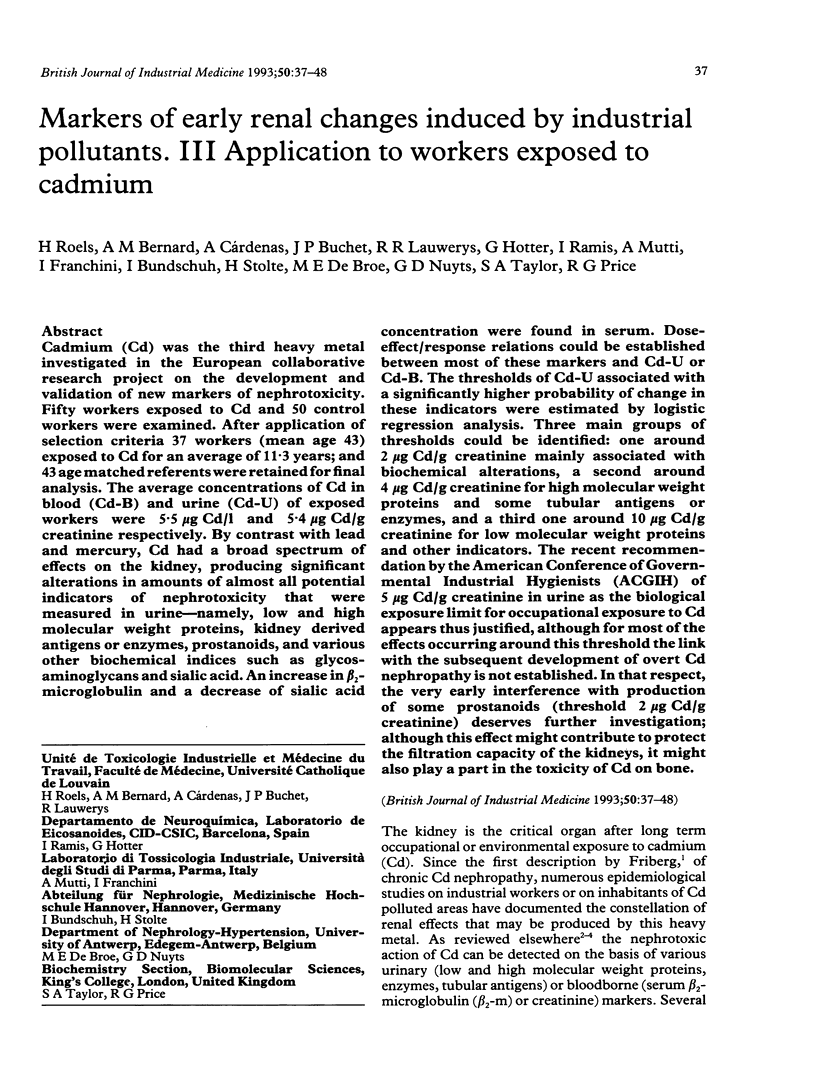
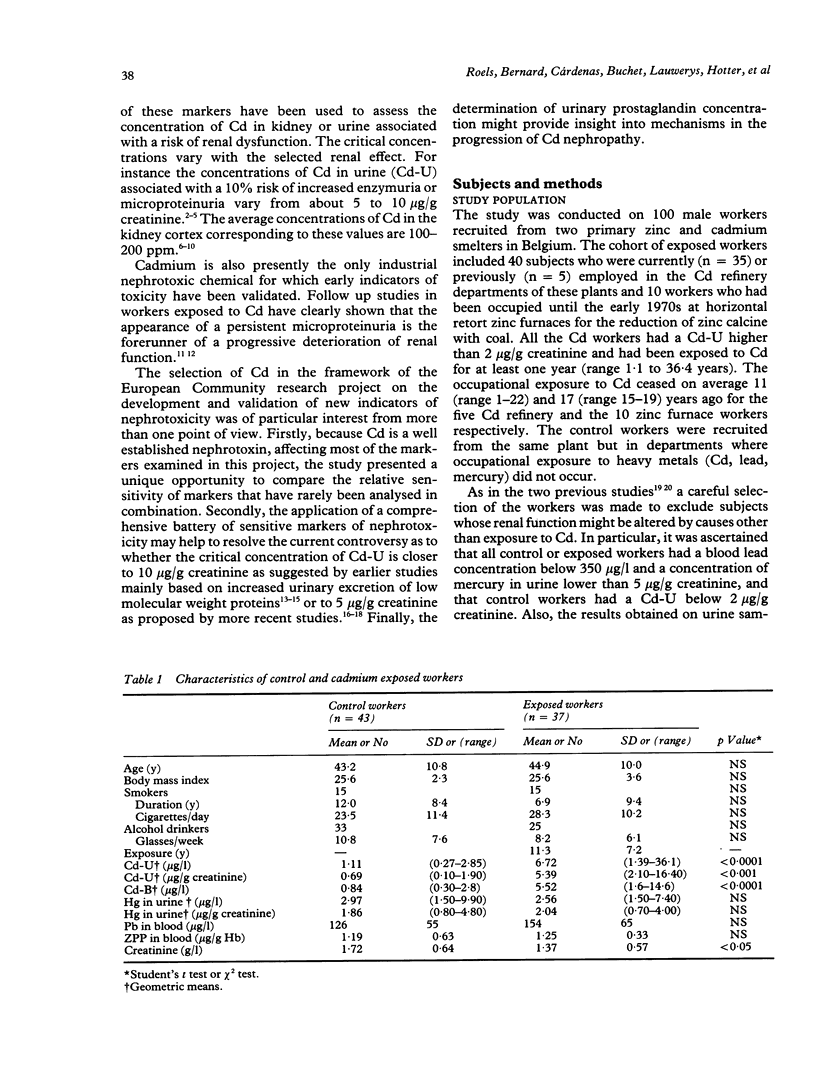
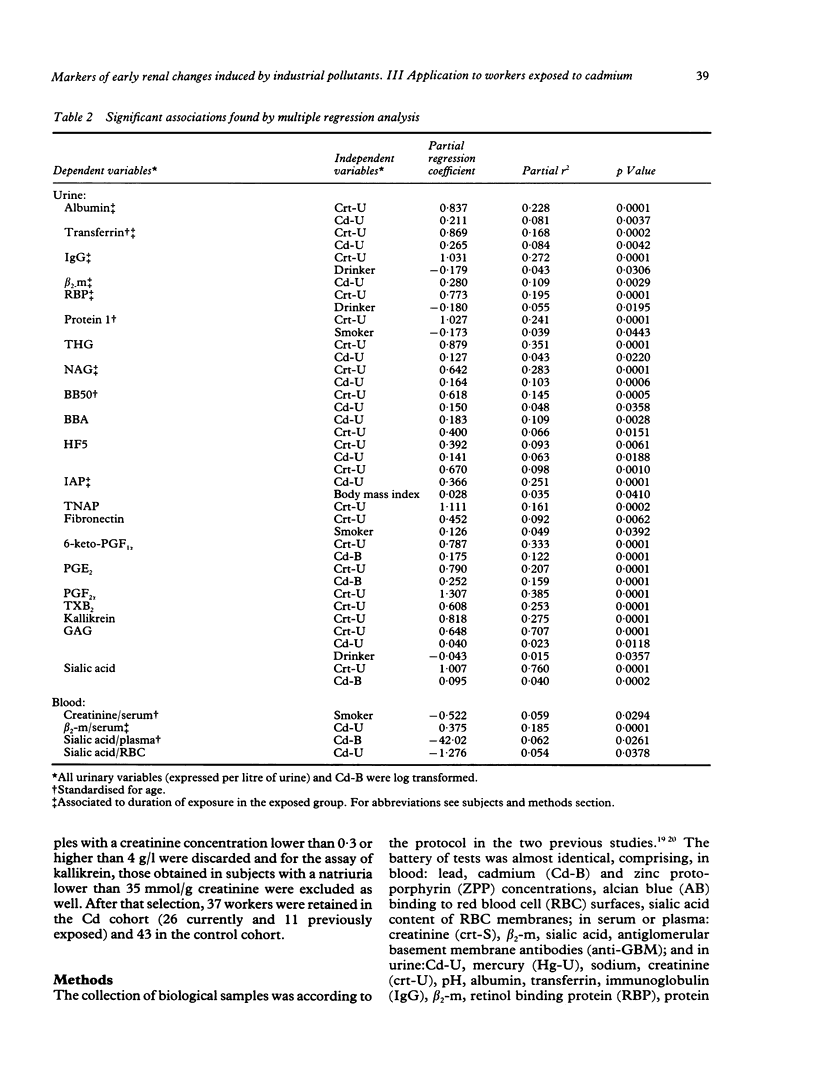
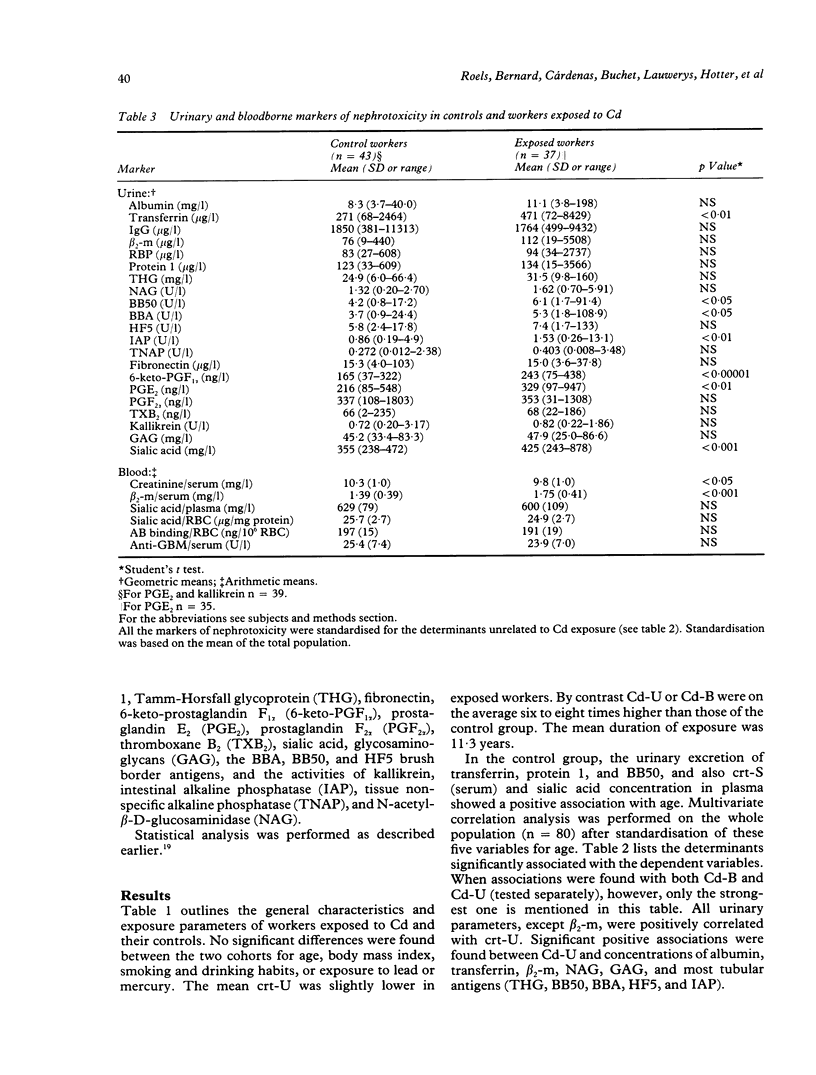
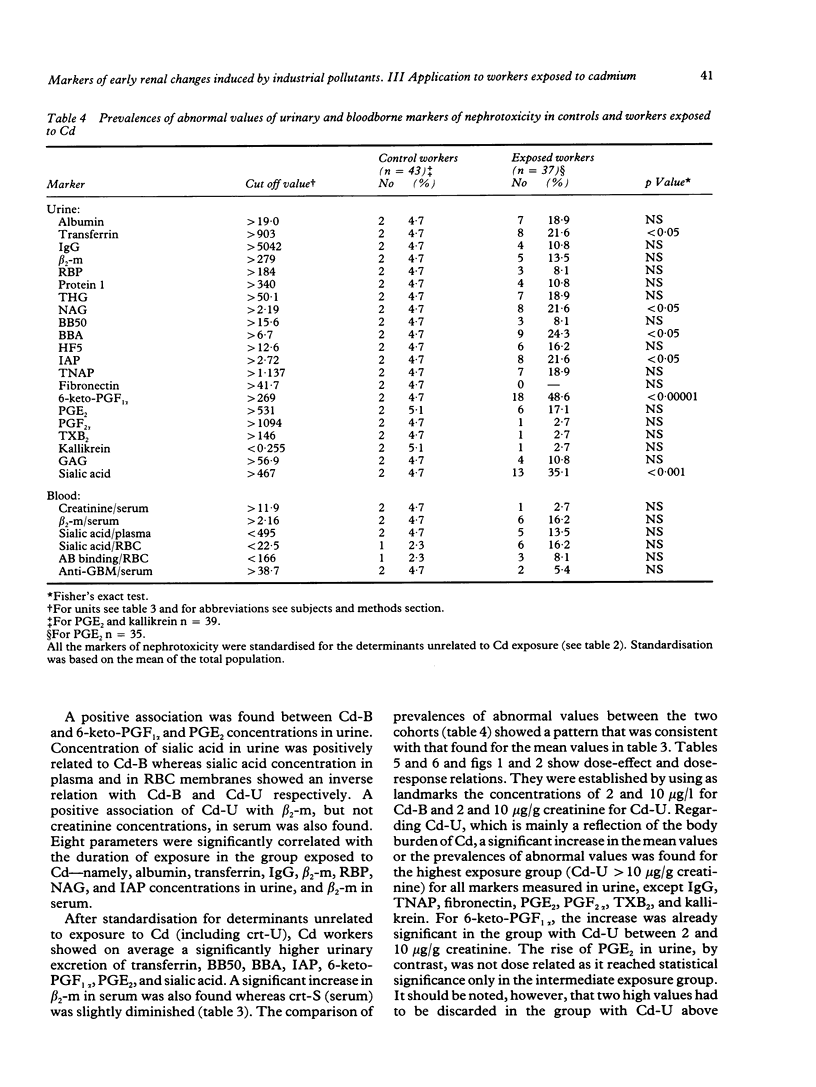
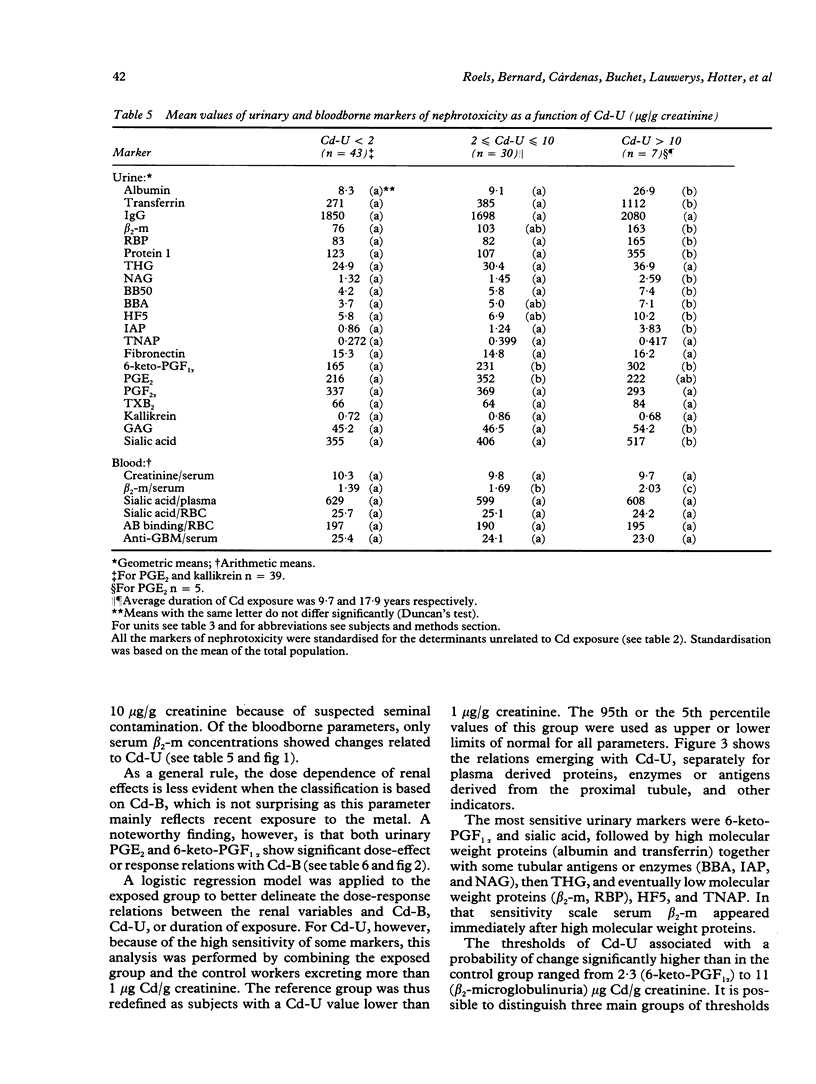
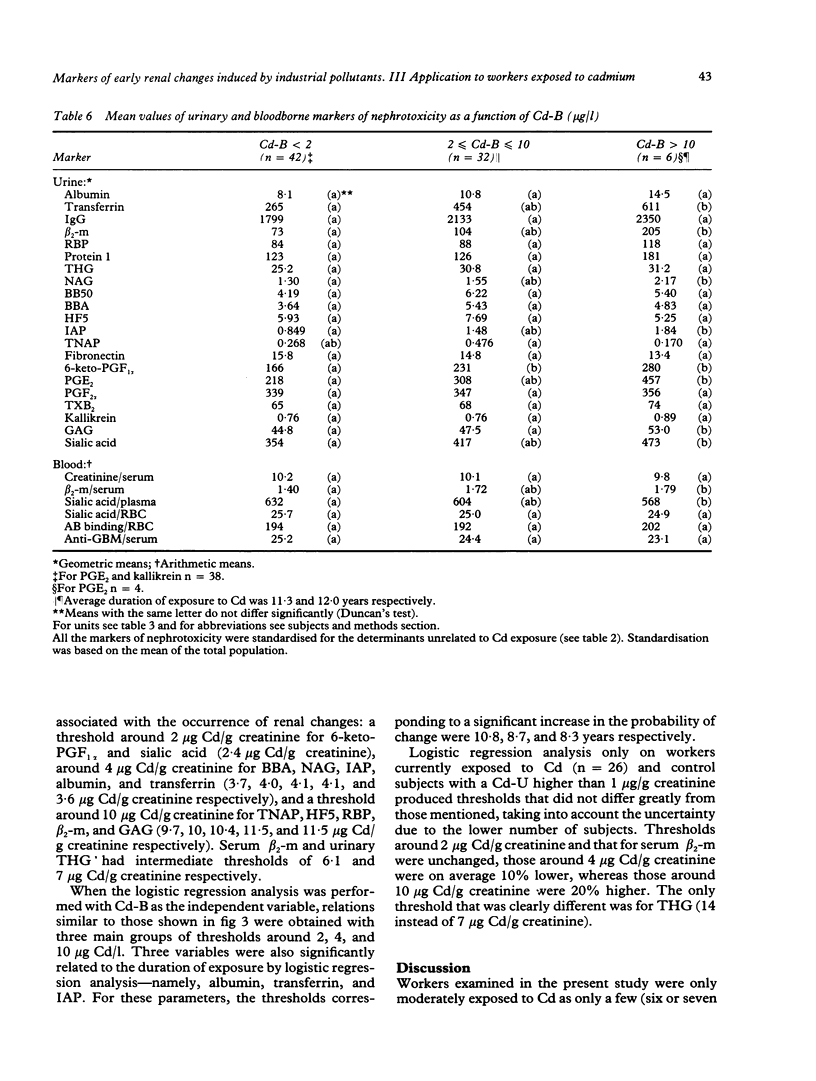
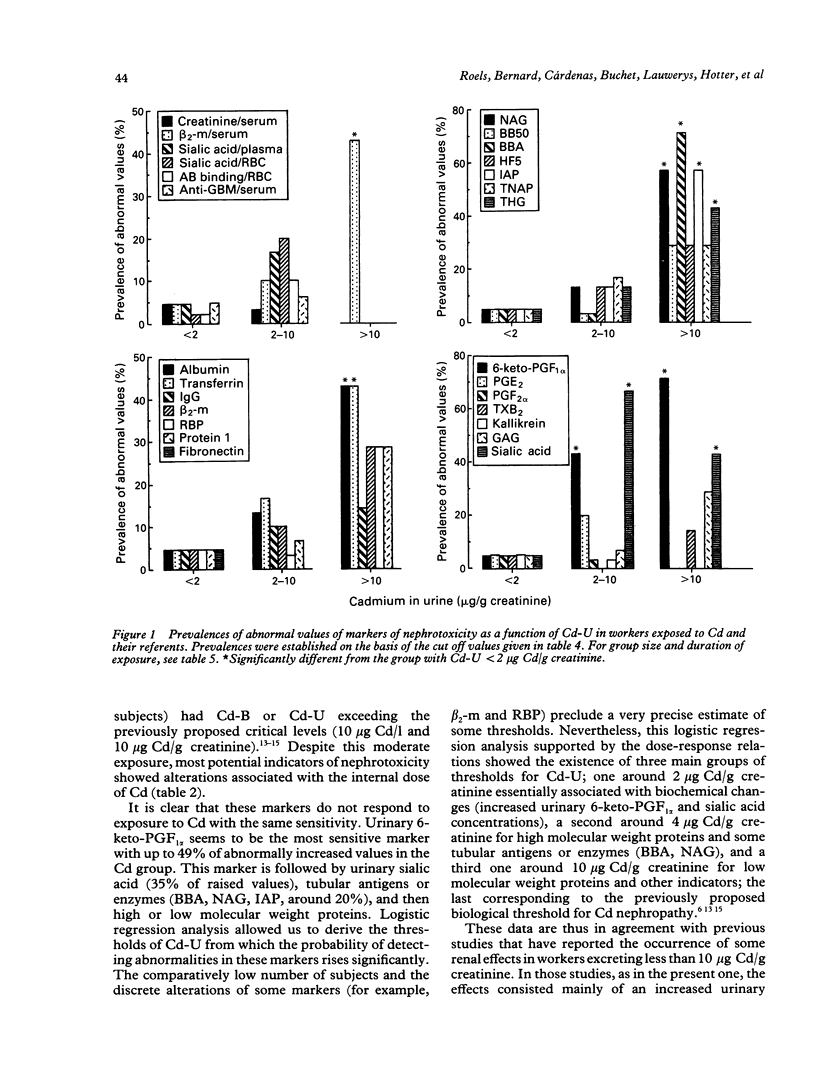
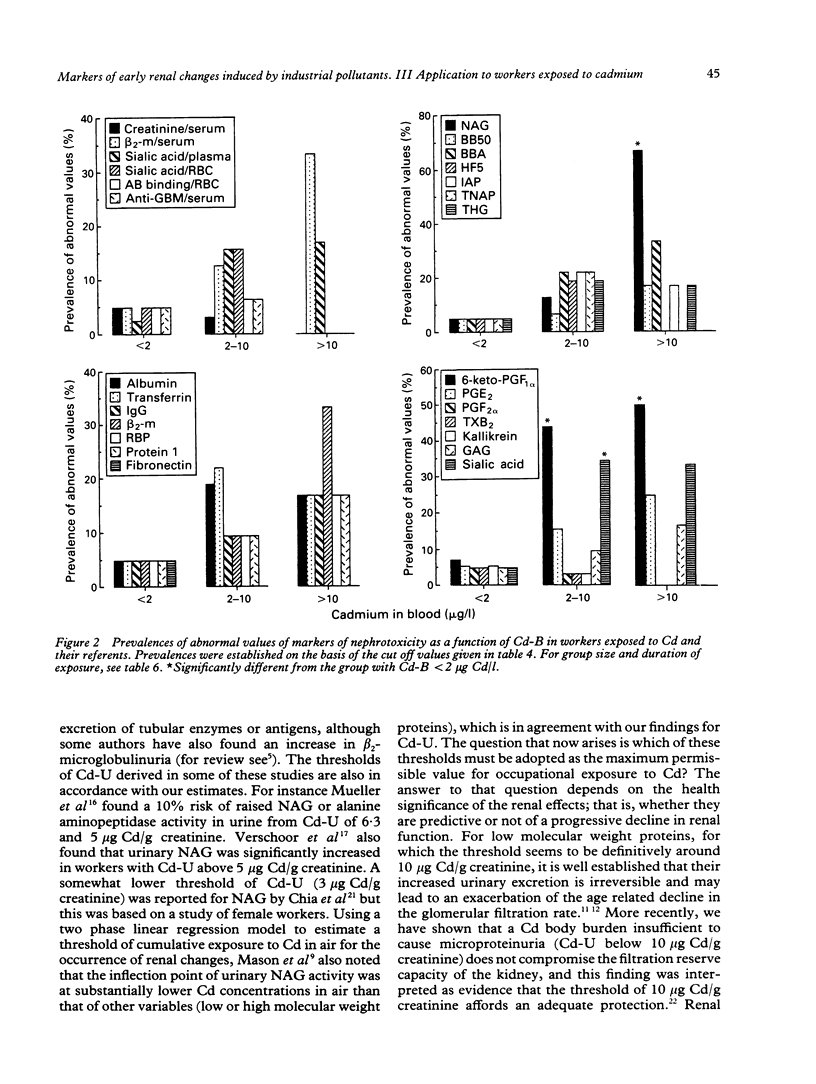
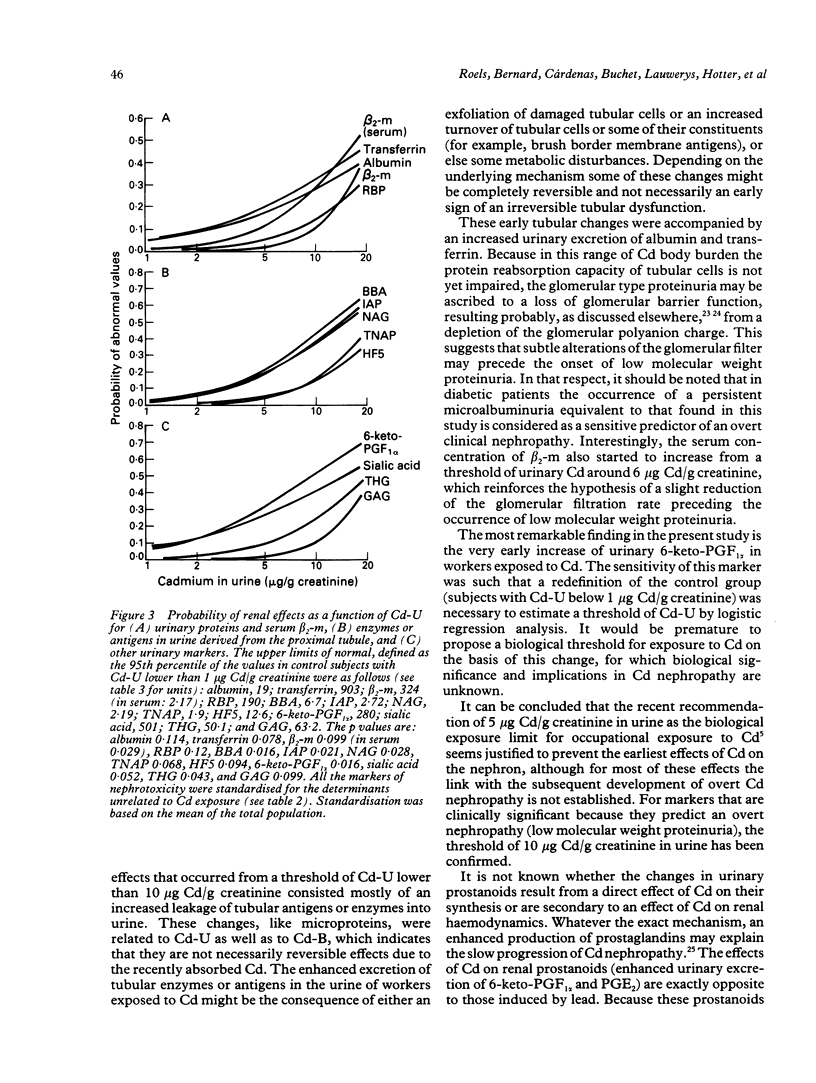
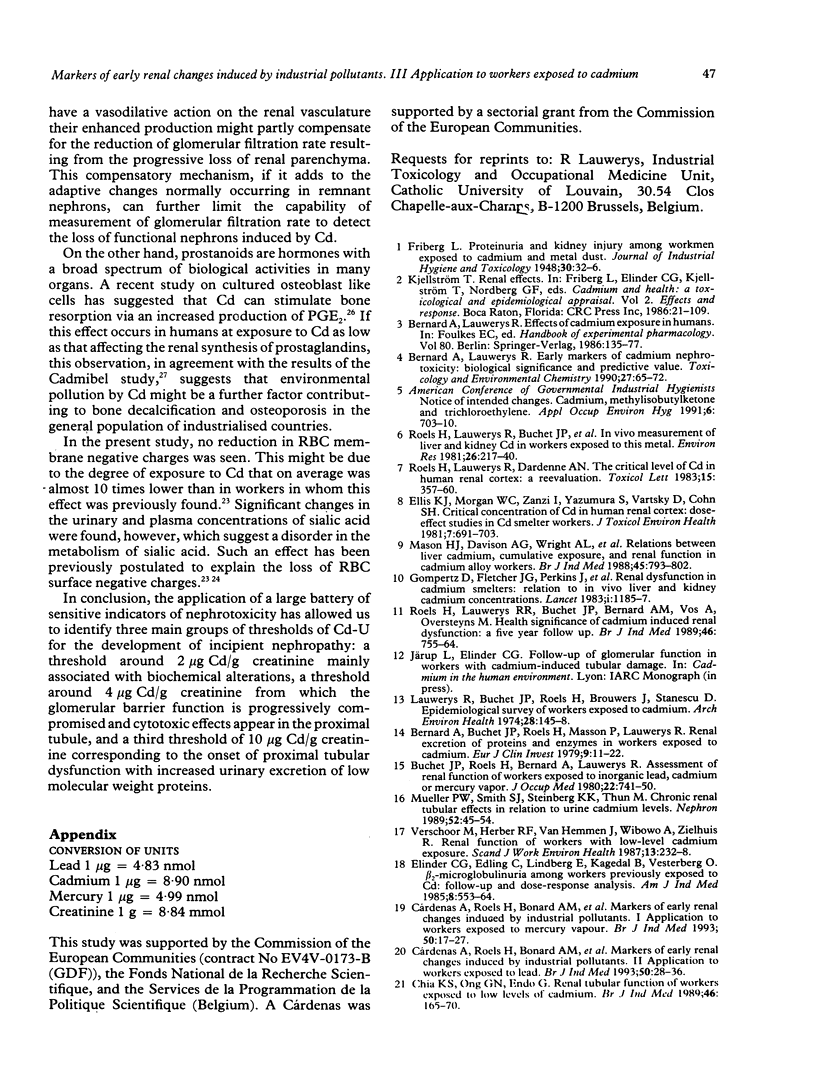
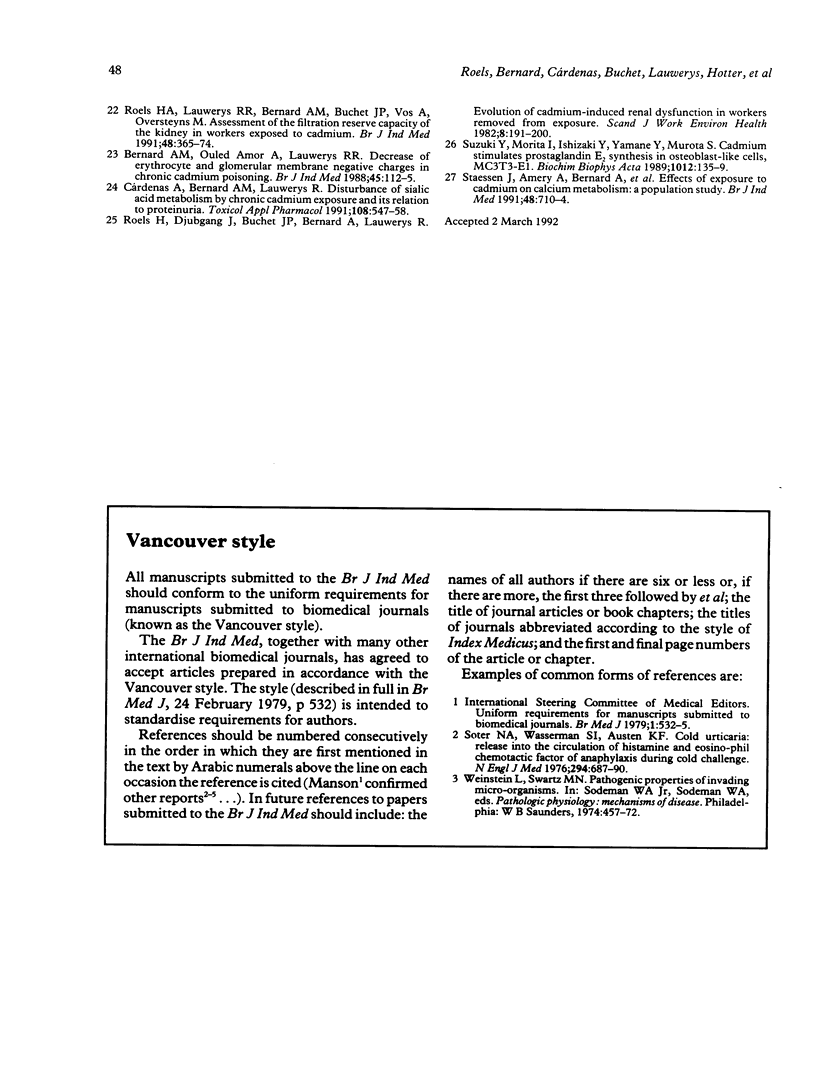
Selected References
These references are in PubMed. This may not be the complete list of references from this article.
- Bernard A. M., Amor A. O., Lauwerys R. R. Decrease of erythrocyte and glomerular membrane negative charges in chronic cadmium poisoning. Br J Ind Med. 1988 Feb;45(2):112–115. doi: 10.1136/oem.45.2.112. [DOI] [PMC free article] [PubMed] [Google Scholar]
- Bernard A., Buchet J. P., Roels H., Masson P., Lauwerys R. Renal excretion of proteins and enzymes in workers exposed to cadmium. Eur J Clin Invest. 1979 Feb;9(1):11–22. doi: 10.1111/j.1365-2362.1979.tb01662.x. [DOI] [PubMed] [Google Scholar]
- Buchet J. P., Roels H., Bernard A., Lauwerys R. Assessment of renal function of workers exposed to inorganic lead, calcium or mercury vapor. J Occup Med. 1980 Nov;22(11):741–750. [PubMed] [Google Scholar]
- Cardenas A., Bernard A. M., Lauwerys R. R. Disturbance of sialic acid metabolism by chronic cadmium exposure and its relation to proteinuria. Toxicol Appl Pharmacol. 1991 May;108(3):547–558. doi: 10.1016/0041-008x(91)90101-j. [DOI] [PubMed] [Google Scholar]
- Chia K. S., Ong C. N., Ong H. Y., Endo G. Renal tubular function of workers exposed to low levels of cadmium. Br J Ind Med. 1989 Mar;46(3):165–170. doi: 10.1136/oem.46.3.165. [DOI] [PMC free article] [PubMed] [Google Scholar]
- Cárdenas A., Roels H., Bernard A. M., Barbon R., Buchet J. P., Lauwerys R. R., Roselló J., Hotter G., Mutti A., Franchini I. Markers of early renal changes induced by industrial pollutants. I. Application to workers exposed to mercury vapour. Br J Ind Med. 1993 Jan;50(1):17–27. doi: 10.1136/oem.50.1.17. [DOI] [PMC free article] [PubMed] [Google Scholar]
- Cárdenas A., Roels H., Bernard A. M., Barbon R., Buchet J. P., Lauwerys R. R., Roselló J., Ramis I., Mutti A., Franchini I. Markers of early renal changes induced by industrial pollutants. II. Application to workers exposed to lead. Br J Ind Med. 1993 Jan;50(1):28–36. doi: 10.1136/oem.50.1.28. [DOI] [PMC free article] [PubMed] [Google Scholar]
- Elinder C. G., Edling C., Lindberg E., Kågedal B., Vesterberg O. beta 2-Microglobulinuria among workers previously exposed to cadmium: follow-up and dose-response analyses. Am J Ind Med. 1985;8(6):553–564. doi: 10.1002/ajim.4700080607. [DOI] [PubMed] [Google Scholar]
- Ellis K. J., Morgan W. D., Zanzi I., Yasumura S., Vartsky D., Cohn S. H. Critical concentrations of cadmium in human renal cortex: dose-effect studies in cadmium smelter workers. J Toxicol Environ Health. 1981 May;7(5):691–703. doi: 10.1080/15287398109530012. [DOI] [PubMed] [Google Scholar]
- Gompertz D., Chettle D. R., Fletcher J. G., Mason H., Perkins J., Scott M. C., Smith N. J., Topping M. D., Blindt M. Renal dysfunction in cadmium smelters: relation to in-vivo liver and kidney cadmium concentrations. Lancet. 1983 May 28;1(8335):1185–1187. doi: 10.1016/s0140-6736(83)92465-0. [DOI] [PubMed] [Google Scholar]
- Lauwerys R. R., Buchet J. P., Roels H. A., Brouwers J., Stanescu D. Epidemiological survey of workers exposed to cadmium. Arch Environ Health. 1974 Mar;28(3):145–148. doi: 10.1080/00039896.1974.10666455. [DOI] [PubMed] [Google Scholar]
- Mason H. J., Davison A. G., Wright A. L., Guthrie C. J., Fayers P. M., Venables K. M., Smith N. J., Chettle D. R., Franklin D. M., Scott M. C. Relations between liver cadmium, cumulative exposure, and renal function in cadmium alloy workers. Br J Ind Med. 1988 Dec;45(12):793–802. doi: 10.1136/oem.45.12.793. [DOI] [PMC free article] [PubMed] [Google Scholar]
- Mueller P. W., Smith S. J., Steinberg K. K., Thun M. J. Chronic renal tubular effects in relation to urine cadmium levels. Nephron. 1989;52(1):45–54. doi: 10.1159/000185581. [DOI] [PubMed] [Google Scholar]
- Roels H. A., Lauwerys R. R., Bernard A. M., Buchet J. P., Vos A., Oversteyns M. Assessment of the filtration reserve capacity of the kidney in workers exposed to cadmium. Br J Ind Med. 1991 Jun;48(6):365–374. doi: 10.1136/oem.48.6.365. [DOI] [PMC free article] [PubMed] [Google Scholar]
- Roels H. A., Lauwerys R. R., Buchet J. P., Bernard A. M., Vos A., Oversteyns M. Health significance of cadmium induced renal dysfunction: a five year follow up. Br J Ind Med. 1989 Nov;46(11):755–764. doi: 10.1136/oem.46.11.755. [DOI] [PMC free article] [PubMed] [Google Scholar]
- Roels H. A., Lauwerys R. R., Buchet J. P., Bernard A., Chettle D. R., Harvey T. C., Al-Haddad I. K. In vivo measurement of liver and kidney cadmium in workers exposed to this metal: its significance with respect to cadmium in blood and urine. Environ Res. 1981 Oct;26(1):217–240. doi: 10.1016/0013-9351(81)90199-7. [DOI] [PubMed] [Google Scholar]
- Roels H., Djubgang J., Buchet J. P., Bernard A., Lauwerys R. Evolution of cadmium-induced renal dysfunction in workers removed from exposure. Scand J Work Environ Health. 1982 Sep;8(3):191–200. doi: 10.5271/sjweh.2476. [DOI] [PubMed] [Google Scholar]
- Roels H., Lauwerys R., Dardenne A. N. The critical level of cadmium in human renal cortex: a reevaluation. Toxicol Lett. 1983 Mar;15(4):357–360. doi: 10.1016/0378-4274(83)90156-x. [DOI] [PubMed] [Google Scholar]
- Soter N. A., Wasserman S. I., Austen K. F. Cold urticaria: release into the circulation of histamine and eosinophil chemotactic factor of anaphylaxis during cold challenge. N Engl J Med. 1976 Mar 25;294(13):687–690. doi: 10.1056/NEJM197603252941302. [DOI] [PubMed] [Google Scholar]
- Staessen J., Amery A., Bernard A., Bruaux P., Buchet J. P., Claeys F., De Plaen P., Ducoffre G., Fagard R., Lauwerys R. R. Effects of exposure to cadmium on calcium metabolism: a population study. Br J Ind Med. 1991 Oct;48(10):710–714. doi: 10.1136/oem.48.10.710. [DOI] [PMC free article] [PubMed] [Google Scholar]
- Suzuki Y., Morita I., Ishizaki Y., Yamane Y., Murota S. Cadmium stimulates prostaglandin E2 synthesis in osteoblast-like cells, MC3T3-E1. Biochim Biophys Acta. 1989 Jul 11;1012(2):135–139. doi: 10.1016/0167-4889(89)90086-4. [DOI] [PubMed] [Google Scholar]
- Verschoor M., Herber R., van Hemmen J., Wibowo A., Zielhuis R. Renal function of workers with low-level cadmium exposure. Scand J Work Environ Health. 1987 Jun;13(3):232–238. doi: 10.5271/sjweh.2065. [DOI] [PubMed] [Google Scholar]


